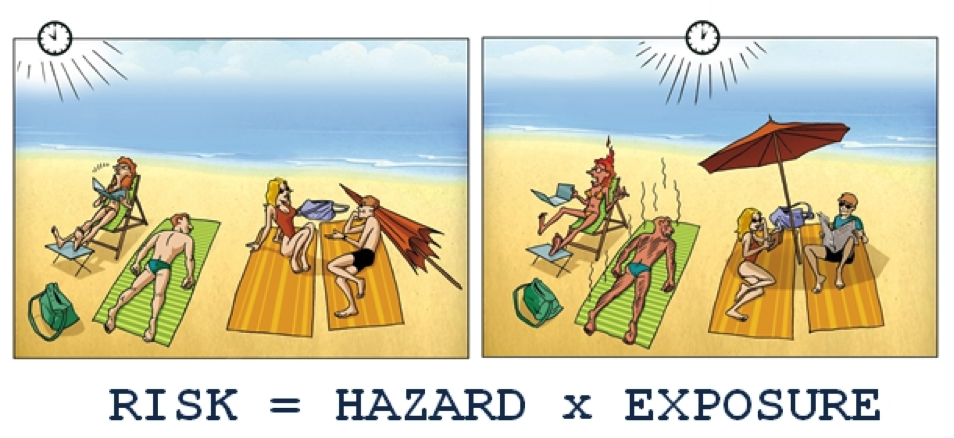Risk vs Hazard [factsheet]
Are risk and hazard synonyms? When does a hazard become a risk? How can risks be minimised and avoided?
These two terms are often used to describe the same or similar things, but this isn’t entirely accurate as risk and hazard relate to very distinct concepts. Not all hazards represent a risk; it is exposure which makes all the difference.

Hazard: The innate property of a physical object, substance or an organism which enables it to cause harm
A hazardous object or condition has a built-in ability to cause harm. Examples include: an icy road, uneven pavements, machinery, noise, wild animals and UV radiation from the sun. Conditions and situations such as these have the ability to cause harm – ie, slips, trips, falls, or even sunburns which could cause cancer on repeated or excessive circumstances – but will they? Just because an object or situation has the ability to cause harm, we know from experience that this is not frequently the case. When preventive measures are taken, such as using the right shoes and protective gear or having the right pressure on our tires, risks can be minimised or completely avoided.
Exposure: The extent to which the recipient is subjected or exposed to a hazard
Exposure is a necessary condition for a hazard to become a risk. If humans or the environment are exposed to a hazardous substance or ingredient above a certain safe level, this means that the odds are more likely for the individuals to be at increased risk for harm. In the example above regarding UV sunrays, humans need a certain amount of exposure to sunlight to stay healthy. However, excess exposure posses a risk which can minimized by use of sunscreen, sunshades and sunglasses. In another example, many food additives have a safe limit of acceptable daily intake is set in mg/kg bodyweight per day which have been established by data from the scientific community and responsible authorities. If exposure remains within this limit, and this is typically the case, then there is no risk. Even occasional exceedances may not pose a risk since there are safety factors built into the safe limit, and it is a limit for exposure every day for a lifetime.
Risk -The likelihood that harm will actually occur
The concept of risk can be simply captured in the equation: “Risk = Hazard x Exposure”. For a hazardous object or situation to become a risk, there must be exposure. For example, a wild and dangerous animal will always represent a hazard, but as long as it remains properly caged it will not represent a risk.
We live surrounded by hazards and therefore, constantly perform risk assessment to make our decisions. While deciding when to cross the road, what food to eat or whether to drive our car or take the train, we are assessing the potential hazards and the risks they actually represent, normally trying to minimise any potential risk. Some hazards, like those related to food intake or of travel cannot be avoided – unless we choose not to eat or not to travel in which case new hazards and risks would have to be negotiated. Life is risk!.
Risks and hazards in chemicals
“All things are poison, and nothing is without poison; the dose determines the poison.”
Paracelsus (1493 –1541)
The fact that a chemical is deemed to be a hazard does not necessarily mean there is a risk. The chemical’s built-in ability to result into harm classifies it as hazardous in some cases, however, if it is handled safely and under controlled conditions, it is safe for use in appropriate applications. Frequency and amount of exposure are two important elements to consider when determining the level of risk derived from exposure to a particular substance.
Risk assessments are scientific analysis to determine the level of exposure to a hazard which is safe and the level which is dangerous. A safe limit also known as an acceptable daily intake (ADI), tolerable daily intake (TDI) or Derived No Effect Level (DNEL – REACH terminology) provide levels below which there should be no adverse effects. Even going above this limit occasionally does not mean there is a risk since large safety factors are incorporated in these levels which relate to daily exposure for a lifetime.

